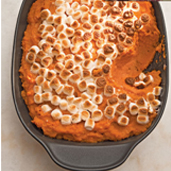Sweet Potatoes with Marshmallows
Featuring Fiore Sardo
by Chef Shea Gallante, as seen in NY Magazine
This recipe was featured in the November 1st issue of NY Magazine. The addition of smoked sheep milk cheese makes it an even more decadent version of the classic Thanksgiving favorite.
10 medium sweet potatoes
1/4 cup pure maple syrup
3 sticks butter
2 cups heavy cream
2 star anise
1 tsp. fennel seeds
1 tsp. whole mace skins
1 tsp. white peppercorns
1 vanilla bean, split
1 garlic clove
3 sage leaves
2 oz. Fiore Sardo, grated
1 1/2 cups mini-marshmallows
Sea salt and pepper
Instructions
Preheat the oven to 295°. Poke holes in the sweet potatoes with a fork. Set potatoes on a 10-inch square of aluminum foil, and brush with maple syrup. Place 1 tablespoon of butter on top of each, and season with salt and pepper. Wrap each potato in foil and seal tightly. Bake wrapped potatoes in the oven for about 40 to 60 minutes, until fork-tender.
In a saucepan, add the cream, spices, vanilla bean, garlic, and sage, and heat to just below a simmer. Remove mixture from heat, season with salt and pepper, and cover, allowing mixture to steep. After about 30 minutes, strain the cream. In a small saucepan, melt the remaining butter and cook until just before it starts to brown.
Scoop the potatoes out of their skins and into a large saucepan. With a hand mixer, mash the potatoes on low for about 2 to 3 minutes. Allow the mixture to sit uncovered for 10 minutes. Slowly add the cream and melted butter to the potatoes, and blend with the hand mixer.
Spread the potato mixture into a baking dish, and sprinkle with the smoked cheese. When ready to serve, place the potatoes under the broiler until the top is golden brown. Remove, add the marshmallows, and return to the broiler to gratinée the marshmallows to a toasted brown (watching carefully to avoid burning). Sprinkle with sea salt and serve.


